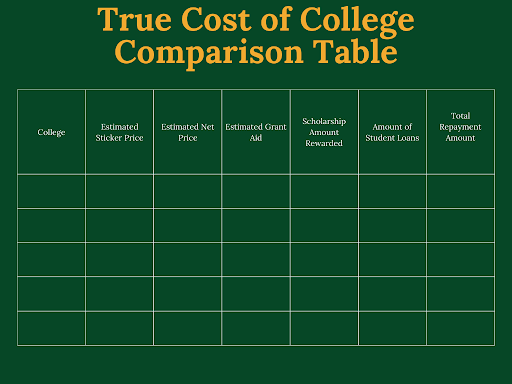Cost of attendance or COA is a term you’ll come across often when researching different colleges and their fees. Families often confuse cost of attendance with college tuition. The fact is although the two are associated, they are two completely different things. College tuition is just one part of the total cost of attendance. Here’s the rundown on what is cost of attendance in college and what expenses are included in the calculation.
What is Cost of Attendance?
Cost of attendance is the estimated total amount it will cost you to attend a specific college for one full academic year. This takes into account the cost of tuition and fees, room and board, textbooks, transportation, and school supplies. It also takes into consideration loan fees, disability, dependent care, and other miscellaneous expenses.
The cost of attendance in any one college will be different for every student. Your COA will depend on four main factors. The first is your enrollment status – whether you’re enrolled as a full time or part time student. The second determining factor is the type of degree program you’re enrolled in – undergraduate or graduate degree. The third is whether you’re paying in-state or out-of-state tuition. And the fourth is whether you live on campus or off campus. Each of these options will determine your total cost of attending any college.
Congress dictates the cost of attendance around the fall or spring. Every year, the college may adjust their particular COA to reflect any changes related to tuition, inflation, and other costs. Under Federal law, universities and colleges are required to provide students with a comprehensive cost of attendance.
Factors that determine your school’s estimated COA
There are 5 major expenses that go into calculating the total COA Then there are a few other miscellaneous expenses that also need to be taken into consideration.

1. Tuition and Fees
Tuition makes up the largest chunk of the cost of attendance. The base tuition is usually the same for every student that attends that particular college. However, the final cost of tuition may be affected by your chosen major and number of credit hours you take per semester or quarter.
Fees are also a part of the COA. What the fees cover depends on the school. It could vary from one college to another. Some but not all colleges charge “green” fees to cover any energy costs and others may charge an enrollment fee.
It’s important to note that the COA of attending any college will be different for students who are residents of the state and out-of-state students. Generally, students pay much lower fees when attending an in-state college.
2. TEXTBOOKS and supplies
Cost of attendance also includes books and potential supplies, though this varies greatly from one major to another and even among students.
For example, an English major may have to spend more on books, while an Art major may need to spend more on supplies. Before attending college, you might want to figure out your personal estimated cost for the textbooks or supplies you’ll need. Your school’s website, Amazon, Barnes and Noble, or other retailers all list prices for these items.
3. Room and Board
The price reflected in the COA is for your dorm room and any expenses that might occur from living on campus. However, room and board costs can vary widely depending on your choice of accommodation. A student’s room and board costs will be much higher if they choose to rent an apartment or house off-campus during their college years. Take a look at the pros and cons of staying on-campus vs living off to determine which may be a better option for you.
If you’re attending a college close to home, you can save a lot by living at home with your parents. The savings with this single step can be significant.
4. Transportation
Students often overlook transportation when calculating the expenses associated with college. This is a mistake. Transportation is a part of the total cost of attendance. Even if you’re staying in the dorm and don’t need to drive to classes, if you’ve taken your car to college, you’ll have to pay to park your car on campus. If you’re staying off-campus, you’ll have to pay for transportation to and from class. Parking fees and bus tickets can add up to a substantial amount over four years.
5. Miscellaneous Costs
The five points above only consider the major expenses that students encounter while in college. In addition, there are several other smaller expenses that come up during the course of the month. For example, there’s laundry, cell phone, eating out, and other personal expenses. These expenses may seem negligible but they can add up. You have to factor these costs into the total cost of attendance.
Ultimately, it’s the choices that a student makes that ultimately determines their COA,
How Cost of Attendance Affects Financial Aid
While cost of attendance may just seem like another number, it’s one you definitely need to know. Your COA will also determine how much federal and institutional financial aid you’re eligible to receive.
You MUST fill out the Free Application For Federal Student Aid (FAFSA) to avail of any federal or institutional financial aid. This form asks for information regarding family income, family size, total taxes and other financial details. This information is used to calculate your Expected Family Contribution (EFC).
Once a college approves your application, they will send you the final cost of attendance. They will then subtract your EFC from the quoted COA to determine your financial need. If a school has a higher COA, you could be eligible for more financial aid for that particular school.
Use College Raptor to discover personalized college matches, cost estimates, acceptance odds, and potential financial aid for schools around the US—for FREE!
| Lender | Rates (APR) | Eligibility | |
|---|---|---|---|
 |
5.34%-15.96%* Variable
3.99%-15.61%* Fixed
|
Undergraduate and Graduate
|
VISIT CITIZENS |
 |
4.92% - 15.08% Variable
3.99% - 15.49% Fixed
|
Undergraduate and Graduate
|
VISIT SALLIE MAE |
 |
4.50% - 17.99% Variable
3.45% - 17.99% Fixed
|
Undergraduate and Graduate
|
VISIT CREDIBLE |
 |
6.00% - 13.75% Variable
3.99% - 13.75% Fixed
|
Undergraduate and Graduate
|
VISIT LENDKEY |
 |
5.50% - 14.56% Variable
3.69% - 14.41% Fixed
|
Undergraduate and Graduate
|
VISIT ASCENT |
 |
3.70% - 8.75% Fixed
|
Undergraduate and Graduate
|
VISIT ISL |
 |
4.99% - 16.85% Variable
3.47% - 16.49% Fixed
|
Undergraduate and Graduate
|
VISIT EARNEST |
 |
5.00% - 14.22% Variable
3.69% - 14.22% Fixed
|
Undergraduate and Graduate
|
VISIT ELFI |






